Digital Marketing 101: The Basics
Everything You Need to Know to Master the Terminology of Digital Marketing

To search this page press CTRL+F or Command+F for mac users.
404 Error–The error message that shows up when you click on a dead link.
Ad Extensions–More informative ads for Google Ads.
Ad Manager Account–Facebook Advertising Account agencies use to help clients run advertising for their business.
Ad Network–Group of websites where an ad can appear.
Ads (Google Ads)–Google Platform that allows businesses to run advertising on their site. Primary platform for PPC.
Analytics (Google Analytics)–Google platform that allows for the collection of data about website visitors.
Anchor Text–The clickable words that lead to another link.
Adsense (Google Adsense)–Google platform that allows website to earn profit for running ads on their website.
Algorithm–Process a computer uses to complete a task.
Automation - Using computer programs to complete repetitive tasks without having to manually do it.
Backlink–When one website link leads to another website.
Banner Ad–Digital image that can be placed in various size dimensions as an advertisement.
Bing–A web search engine just like Google
Bing Ads–Think Google Ads, but for Bing.
Blog–A web page that is regularly updated with new written content.
Bot–An automated program that visits sites, likes, comments, and shares posts on your behalf.
Bounce Rate–Percentage of website visitors that leave immediately without clicking anything on your site.
Breadcrumbs–Navigation links at the top of a webpage that better help the user understand where on the website they are. These links often appear near the web page’s title and look something like this: Home > Services > Specific Service
Business Manager–Facebook platform that allows managers to run campaigns for multiple ad accounts.
Campaign–Series of advertising messages that promote a product or service.
Click-Through-Rate–Shows how often people click on an ad.
Code–The language of your computer to build a site.
Contact Form–Fillable section on your website for visitors to contact website owners. Commonly used to collect leads.
Content–Any form of media that is either read, watched, or interacted with.
Conversion Rate–Rate that customers complete a predefined goal.
CPA (Cost-Per-Acquisition)–How much money is spent to acquire one new customer.
CPC (Cost-Per-Click)–The amount spent for one click on an ad campaign. Companies only pay when someone clicks on the link.
CPM (Cost-Per-Thousand)–Amount an advertiser pays for one thousand impressions
CRO (Conversion Rate Optimization)–Aims to improve a websites conversion rate.
CSS (Cascading Style Sheets)–A document of code that tells the website’s HTML how it should be appear on screen.
CTA (Call-To-Action)–Used to push visitors to a specific conversion.
CTR (Click-Through-Rate)–ratio of how many times an ad was clicked on, verses shown.
Dashboard–Webpage that shows the performance of a website or campaign.
Digital Marketing–A vague term that defines everything we do.
Directory–Lists websites with similar themes that fit in a similar category.
Display Ads–Ads on a display network.
Display Network–Collection of websites that show an advertisement.
DNS (Domain Name System)–Translates website URLs into IP Addresses.
Duplicate Content–Seeing the same content on two different websites. This hurts SEO severely
Ecommerce–Stand for Electronic Commerce. Fancy way of saying an online business.
Email Automation–Marketing system to automatically send out emails to customers/leads based on predefined triggers.
Email Marketing–Use of emails to acquire sales, leads, or conversions.
Facebook–The largest social platform in the world. I’m sure you’ve heard?
Facebook Business Page–Public webpage to represent a company.
Facebook Ads Manager–Manager tool to create and monitor Facebook ads.
Google–Bet you already knew it's the largest search engine in the world.
Google Ads–Google’s online advertising platform.
Google Adsense–A Google Platform that allows websites to run advertising on their site, and generate revenue from it.
Google Analytics–Tool that allows businesses to track nearly every aspect of their website.
Google My Business–How businesses show up on Google.
Google Maps–Location and navigation service to find businesses.
Hashtag–Symbol “#” used in social media as a way to target content for other users to find.
Header–Top portion of webpage.
Header Code–Certain code so the header can be viewed across all pages on a website.
Header Tags–Used to categorize text heading on a web page (usually h1, h2, h3, etc).
Heatmap–Graphical representation of where people interact most with your site.
HTML–Codes that tell a web browser how to display a website.
HTTP–Protocol used by the web to determine how data is formatted and transmitted.
HTTPS–A secured version of HTTP.
Hyperlink–Creates a link from one webpage to another.
Impression–How many times an ad or post was shown.
Inbound Marketing–Strategies used to attract new users to a website.
Instagram–Bet you already knew it's the number one visual social media platform in the world.
IP Address–Unique number that identifies a device using the internet to communicate over a network.
Java–Programming language used to create apps.
Javascript–The scripting language of Java.
Keyword–Word indicative of a major theme.
Keyword Phrase–Phrase indicative of a major theme.
Keyword Density–Percentage of how often a keyword or phrase appears on a webpage.
Landing Page–Destination page a user clicks.
Lead–Potential customer.
Link–string of HTML used to connect to a website.
LinkedIn–Social network to connect business professionals.
Link Network–Link building strategy to interconnect networks back to each other.
Lookalike Audience–targeted audience created from an already existing audience that has a common interest.
Long Tail Keyword–Key phrase that is longer in length that matches with a users search.
Meta Tags–Adds contextual information for users when using search engines. (The small text below the heading of a google search).
Meta Description–Gives description of page in 160 characters or less.
Meta Keyword–Specific meta tag that displays the keyword address in a page.
NAP(Name, Address, Phone Number)–Acronym used to help build local SEO.
Organic–non-paid traffic through a search engine.
Paradise Marketing–The best digital marketing agency out there. DUH!
PPC (Pay-Per-Click)–Advertising model where advertisers are only charged when someone clicks on the ad link.
PDF–Digital version of a document.
Query–Term for what a user types in a search engine.
Rankings–General term for what position a website sites at in a search engine.
Redirect–Way in which a web browser takes a user to a different page.
Referral–A lead that came from another source.
Remarketing–Type of ad that shows a different type of ad to visitors who have already visited a website.
ROI–Return on Investment. What every business person wants.
Search Engine–Program that searches through an index of information.
SEM (Search Engine Marketing)–Vague term that just means an agency trying to market through a search engine (ie: PPC).
SEO (Search Engine Optimization)–A fancy way of attempting to land on the first page of google search results.
Tracking Code–Tracks information about a user who visits a site.
Twitter–Interactive social media network where users “tweet” out messages.
Unique Visitors–Shows how many different users visited a site.
URL–Address of a webpage.
UI–Stands for User Interface. What people see when on an app or website.
UX–Stand for User Experience. How users interact with an app or website.
Yelp–Social review platform where users can review local businesses.
Youtube–Largest video sharing network in the world.
About the Creator
Ryan Cooper
Entrepreneur
Founder of Paradise Digital Marketing
All donations are greatly appreciated! They go towards my business and my college education! Thank you!
Contact me!
https://www.instagram.com/itscoop_04/
Email: [email protected]






Comments
There are no comments for this story
Be the first to respond and start the conversation.